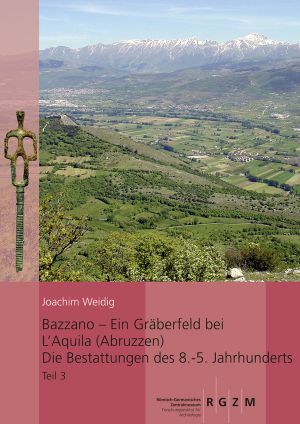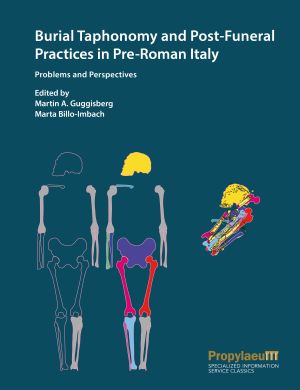Weidig, Joachim
Bazzano – ein Gräberfeld bei L’Aquila (Abruzzen): Die Bestattungen des 8.-5. Jahrhunderts v. Chr.
Bazzano near L'Aquila is one of the largest pre-Roman burial sites in Apennine Central Italy and even surpasses the necropolises of Fossa and Campovalano in the number of graves.
More than 500 burials of the Orientalising and Archaic period (8th-5th century BC) from the excavations of the Soprintendenza per i Beni Archeologici dell'Abruzzo from 1992-2004 are presented and analysed in this publication for the first time.
Above all, Etruscan pottery imports and their local adaptations enable a finer dating of the graves with their seemingly older traditional Italic decorative elements and weapons within an absolute chronology. In this way, the occupation sequence of the necropolis in four main phases, established on the basis of seriations and grave overlaps, can be better compared with the existing chronology systems.
In addition to questions on burial customs and social structures, the main part of the work is devoted to the classification and chronology of typical Middle Italian objects that are widespread far beyond Bazzano. With the complementary anthropological contributions, the picture of a mobile Iron Age population is sketched, which differed in its lifestyle from the individuals buried in the neighbouring necropolis of Fossa. Possibly this is due to a pronounced pastoral economy, transhumance or a very active warrior class, whose status is also emphasised by the high number of graves containing weapons.
Bazzano – ein Gräberfeld bei L’Aquila (Abruzzen): Die Bestattungen des 8.-5. Jahrhunderts v. Chr.
Bazzano near L'Aquila is one of the largest pre-Roman burial sites in Apennine Central Italy and even surpasses the necropolises of Fossa and Campovalano in the number of graves.
More than 500 burials of the Orientalising and Archaic period (8th-5th century BC) from the excavations of the Soprintendenza per i Beni Archeologici dell'Abruzzo from 1992-2004 are presented and analysed in this publication for the first time.
Above all, Etruscan pottery imports and their local adaptations enable a finer dating of the graves with their seemingly older traditional Italic decorative elements and weapons within an absolute chronology. In this way, the occupation sequence of the necropolis in four main phases, established on the basis of seriations and grave overlaps, can be better compared with the existing chronology systems.
In addition to questions on burial customs and social structures, the main part of the work is devoted to the classification and chronology of typical Middle Italian objects that are widespread far beyond Bazzano. With the complementary anthropological contributions, the picture of a mobile Iron Age population is sketched, which differed in its lifestyle from the individuals buried in the neighbouring necropolis of Fossa. Possibly this is due to a pronounced pastoral economy, transhumance or a very active warrior class, whose status is also emphasised by the high number of graves containing weapons.
Bazzano – ein Gräberfeld bei L’Aquila (Abruzzen): Die Bestattungen des 8.-5. Jahrhunderts v. Chr.
Bazzano near L'Aquila is one of the largest pre-Roman burial sites in Apennine Central Italy and even surpasses the necropolises of Fossa and Campovalano in the number of graves.
More than 500 burials of the Orientalising and Archaic period (8th-5th century BC) from the excavations of the Soprintendenza per i Beni Archeologici dell'Abruzzo from 1992-2004 are presented and analysed in this publication for the first time.
Above all, Etruscan pottery imports and their local adaptations enable a finer dating of the graves with their seemingly older traditional Italic decorative elements and weapons within an absolute chronology. In this way, the occupation sequence of the necropolis in four main phases, established on the basis of seriations and grave overlaps, can be better compared with the existing chronology systems.
In addition to questions on burial customs and social structures, the main part of the work is devoted to the classification and chronology of typical Middle Italian objects that are widespread far beyond Bazzano. With the complementary anthropological contributions, the picture of a mobile Iron Age population is sketched, which differed in its lifestyle from the individuals buried in the neighbouring necropolis of Fossa. Possibly this is due to a pronounced pastoral economy, transhumance or a very active warrior class, whose status is also emphasised by the high number of graves containing weapons.
Burial Taphonomy and Post-Funeral Practices in Pre-Roman Italy: Problems and Perspectives. Papers of the International Workshop held at the University of Basel, January 12th, 2021
The volume includes papers with individual contributions by the authors dealing with taphonomic processes as well as post-funeral practices and reuse of graves, which could be determined. It is shown that besides the state of preservation, the methods of investigation are enormously important in order to be able to recognize, for example, multiple burials. Likewise, the phenomenon of a closed context, as is quickly assumed in the discovery of a grave, is not a matter of fact in the case of the examples presented. The scientific analyses and evaluations help to understand both the biological and the cultural processes that occur or are carried out after the death of an individual.










